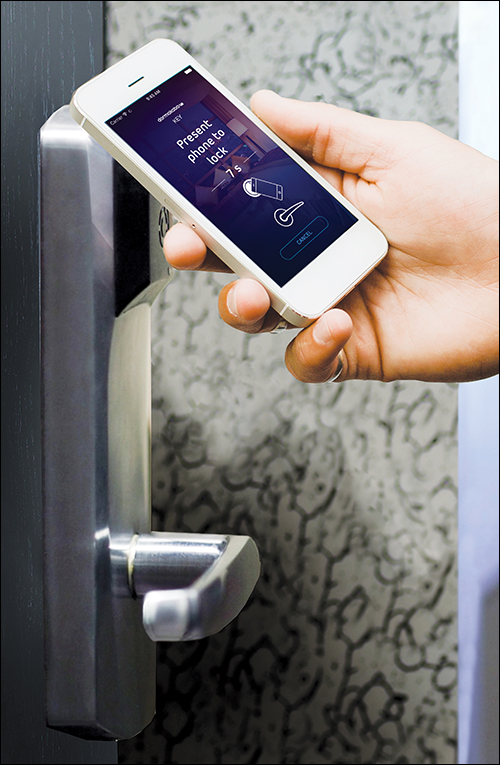Dec 20, 2016Hotel guests have been employing radio frequency identification technology to access their rooms for about ten years. Recently, however, access-control technology company dormakaba has taken the door-lock concept a step further with Bluetooth Low Energy (BLE) units built into its locks that allow guests to unlock their rooms using their smartphones.
A 2015 merger between German door technology firm Dorma Holdings and Swiss access systems company Kaba Group led to the creation of a new company—dormakaba—which owns the Saflok brand. The company also makes door hardware, a variety of electronic access systems, interior glass products and moveable walls.
Hotel guest room access technology has been evolving globally from basic keys to mag-stripe key cards, and more recently to RFID, starting in the late 2000s. The 13.56 MHz passive (typically Mifare) key cards offered a benefit over traditional swipe cards, since they were low-cost and easy to use, and could not be demagnetized by devices people commonly carry, such as cell phones.
Recently, says Alastair Cush, dormakaba's global business owner of lodging systems, his company began offering its Saflok products with ZigBee capability. With the use of ZigBee, the locks themselves can interact with a central server, forwarding data—such as each door lock entry by a guest or employee—to the hotel's management system, as well as receiving updates from the hotel to change their response to specific keys. Since last year, Saflok has been providing another functionality courtesy of BLE technology that enables guests' phones to begin acting as keys.
The newest version of the Saflok system employs three unique wireless technologies: an RFID reader to interrogate an RFID tag in a key card, a transponder using the ZigBee protocol to capture and transmit data, and a BLE unit to receive mobile phone transmissions. Numerous large chain hotels are using the BLE technology, including Hilton Hotel for its Digital Key system, and Marriott for its Mobile Room Key, both of which are available on the hotels' mobile apps. Dormakaba provides a software developers kit (SDK) to enable companies to build the Saflok technology data into their own mobile apps. The company also provides a service related to pairing RFID- or BLE-based room key IDs with the room lock.
When a guest at a hotel employing the new BLE-enabled Saflok system checks in, he or she can typically use an app to do so. "The technology allows guests to bypass the front desk," Cush says. The individual can simply download the hotel app (a reservation can often be made on the app as well). Once ready to check in to a room, the guest can use the app to indicate that he or she has arrived. Typically, the guest can view the number of the assigned room, after which he or she is invited to proceed there immediately.
When the individual places his or her phone directly in front of the lock, the RFID interrogator receives an RF reflection, prompting the BLE unit to wake up. At that moment, the BLE transmission from the phone is received. The lock's built-in IC confirms that the unique beacon transmission is authorized for that lock, prompting the door's mechanism to release. The guest then receives a notice on the phone authorizing him or her to open the door.
Dozens of Marriott and Hilton hotels are using the BLE technology, including Marriott locations previously owned by Group 10 Management. Hilton and Marriott did not respond to requests for comment.
The ZigBee technology built into the Saflok can provide further security for rooms, guests and the hotel company, Cush explains. The locks send back data—piggybacking a transmission from one lock to another—to a gateway linked to the hotel's server, while also receiving data from that server. Therefore, hotels can quickly respond to potential security problems. For instance, if an individual were to find a key card and then try to unlock each door in an effort to locate the corresponding room, the locks would forward that information to the server. The hotel's software would identify unauthorized behavior and security could be alerted. If, in fact, the incident was simply the result of a tired, confused or inebriated guest attempting to find the correct room, security could apprehend and assist that individual.
In another scenario, if a staff member should not have access to rooms—due to having been terminated, for instance—the master key that he or she carries must be disabled. To do so, hotel management can send the unique ID of that person's card through the ZigBee system to every door lock, so that they will no longer respond to that card ID.
The technology enables its hotel company customers to make the check-in process easier for its guests, and to reduce the need for queues at check-in desks. Guest privacy is central to the system, Cush says—no identification related to a guest is ever stored in the locking software, only the unique ID on a key card or in a BLE digital key stored on that person's phone.



